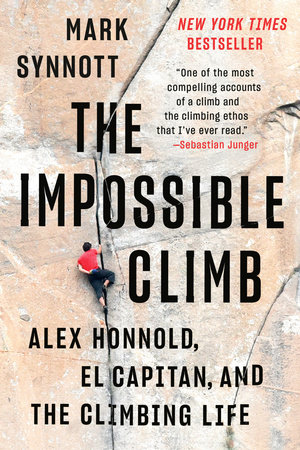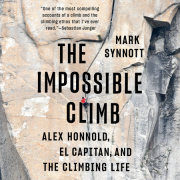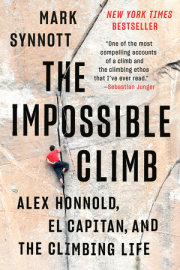Chapter One
"The Hon Is Going to Solo El Cap"
Jimmy Chin took a deep breath, puffed out his cheeks, and exhaled slowly. "There's something I need to tell you," he whispered. "Can you keep a secret?" We stood chest to chest in the Jackson Hole aerial tramway, crammed in with about a hundred other ruddy-faced skiers. It was February 2016, and I was in the Tetons with two of my sons, ages seventeen and fourteen, for their February school vacation. They huddled a few feet away, ignoring me and trying to catch a glimpse of the mountain through a foggy plexiglass window. We had run into Jimmy a few minutes earlier in the line for the tram. I hadn't seen him in almost a year.
"Of course," I whispered back. "What's up?"
Jimmy leaned in until his face was a few inches from mine. His eyes grew wide. "The Hon is going to solo El Cap this fall," he said.
"What? You're messing with me, right?"
"I swear."
I looked around to see if anyone had overheard, but everyone was grooving to AC/DC's "Back in Black," which pumped from a speaker overhead. Jimmy stared back at me, his mouth hanging open.
"He told you?" I asked.
"Yeah. Chai and I are making a film about it. The only people who know about this have all signed NDAs, so please keep it on the down low." Elizabeth Chai Vasarhelyi is Jimmy's wife, and, like him, she's an award-winning documentary filmmaker.
"Is he doing Freerider?"
"Yep."
"When?"
"Probably in early November."
As the reality of what I had just been told sank in, the core of my body quivered. El Capitan. Without a rope. Whoa.
I had climbed Freerider. Or, I should say, I had attempted it. I got to the top after several days of brutal effort, but not before the climb spit me off numerous times along the way, ropes and protective equipment arresting each fall. On a few of the hardest parts, the cruxes, I simply couldn't hang on to the fingertip jams and the flaring cracks where my hands wouldn't stick. So I had been forced to use "aid," meaning I hung on mechanical devices I slotted into cracks in the rock. I cheated. Freerider is so named because it's a "free" climb, which means it can be ascended with nothing more than your hands and feet, the rope acting only as a safety net, in case you slip off. The very best climbers can scale Freerider without aid, but I couldn't think of a single person who hadn't fallen at least once on the way up.
So what in the world was Alex Honnold thinking? El Capitan is 3,000 feet of sheer, gleaming, glacier-polished wall. And he planned to attempt it alone. Untethered. With no equipment. No fail-safe. Hoping for precision in each grab, in each step. One slip, a toe placed a centimeter too high, a shoe canted off a few degrees, a hold grabbed with the wrong hand-and Alex would plummet through the air, possibly screaming, as the ground rushed upward at 120 miles per hour. If he fell off the Boulder Problem, which is the crux of the route, 2,100 feet up the side of the wall, he could be in the air for as long as fourteen seconds-about the time it would take me to run the length of a football field.
I knew it was Alex's dream to be the first to free solo El Capitan-I just never thought it would actually happen. When I took him on his first international expedition to Borneo in 2009, he confided to me that he was thinking about it. In the ensuing years, Alex joined me on more climbing expeditions, to Chad, Newfoundland, and Oman. Along the way, I experienced many classic "Alexisms," like him explaining at the base of the wall in Borneo why he didn't climb with a helmet, even on dangerously loose rock (he didn't own one); or the time in Chad's Ennedi Desert that he sat yawning and examining his cuticles while Jimmy Chin and I faced down four knife-wielding bandits (he thought they were little kids). Perhaps the most classic Alexism of all occurred below a 2,500-foot sea cliff in Oman, when he strapped our rope to his back and told me that he'd stop when he thought it was "appropriate to rope up" (the appropriate place never appeared). But Alex and I also spent countless hours talking about philosophy, religion, science, literature, the environment, and his dream to free solo a certain cliff.
I often played his foil, especially when it came to the subject of risk. It's not that I'm against the idea of free soloing-I do it myself on occasion. I just wanted Alex to think about how close he was treading to the edge. Like most climbers, I had an unwritten list of the people who seemed to be pushing it too hard-and Alex Honnold was at the top. By the time I met him, most of the other folks on my list had already met an early demise (and the rest weren't far behind). I liked Alex, and it didn't seem like there were many people willing to call him out, so I felt okay playing the role of father figure. And Alex didn't seem to mind. In fact, it seemed as though he enjoyed engaging me on the topic of risk, and he climbed over my arguments with the same skill and flair with which he dispatched finger cracks and overhangs. What it all came down to was that for Alex Honnold, a life lived less than fully is a fate worse than dying young.
I looked over at my two sons, still peering through the tram window, eager to ski. Alex was only twenty-nine years old. If he allowed himself to make it to my age, he might have more things outside of himself to live for; presumably his desire for risk would diminish in kind-as it had for me.
But most of all, I wondered, now that Jimmy had burdened me with the knowledge that this was happening, what I should do about it. Should I try to talk Alex out of it? Could I? Or should I support this mad enterprise and help him achieve his dream?
ÒCome with us,Ó I said to Jimmy, when we off-loaded from the tram. ÒWeÕre heading into Rock Springs. ThereÕs a ton of good snow back there.Ó
"I want to," he replied, "but I can't. I have a lot on my plate right now. I just came up to clean out the pipes. I have to get back to work."
He fist-bumped Will and Matt, then leaned in to get me.
"I think I want to write about this," I said, as our gloved fists connected. I had quickly decided that it wasn't my place to try to stop Alex. And if it had been one of my sons or my daughter committing to a challenge like this, I'd try to have the same respect for their decision. It would be hard, but I'd try.
"Yeah, I figured. I'll call you," said Jimmy, jabbing his poles into the snow and pushing off. A few seconds later, he disappeared into the gloom.
Jimmy and I spoke frequently over the next few months. It had been a year since he and Chai had debuted Meru, the first film they co-directed. Meru tells the story of a last great problem of Himalayan climbing, called the SharkÕs Fin, which Jimmy, Conrad Anker, and Renan Ozturk finally solved in 2011. Well-made mountaineering films usually have their moment within the climbing community; then they fade into obscurity. But Jimmy, with ChaiÕs help, had turned Meru into a smash hit. It won the Audience Award at the Sundance Film Festival, was shortlisted for an Oscar, and finished out as the highest-grossing documentary in 2015.
Hollywood had discovered Jimmy and Chai. Companies like Sony, Universal, and 21st Century Fox wanted to know what they were doing next. Jimmy told me that one day he was cold-called by a guy named Evan Hayes, the president of a production company called Parkes+MacDonald. Walter Parkes and Laurie MacDonald are legendary Hollywood producers. In 1994, they helped start DreamWorks SKG motion picture studio, where they went on to produce three Oscar-winning films in a row-American Beauty, Gladiator, and A Beautiful Mind. Hayes had just finished producing the film Everest, a drama inspired by the 1996 Everest tragedy that formed the basis of Jon Krakauer's book Into Thin Air. Hayes loved the climbing genre and wanted to make another film in the same space. And he had been in the audience at Sundance when Meru got a five-minute standing ovation.
Hayes tossed out some ideas he had for mountaineering-related films, but none of them captured Jimmy's imagination. They were about to hang up when Jimmy decided to share a half-formed notion that had been floating in his mind for the past few months.
"Well, there is this one idea I've been playing with," he said. And then he told Hayes about Alex Honnold, the world's greatest free soloist. He didn't mention El Capitan, because at that moment he had no idea Alex was thinking about the free solo. In all the years he had known Alex, he had never once asked him about it. And Alex hadn't yet told a soul that he was seriously considering it.
"That's it," said Hayes. "That's the film."
Jimmy backtracked. "Well, um, yeah, but I'm not really sure I actually want to make that film. I need to think about it."
Later, he talked it over with Chai, and they decided she should call Alex to size him up, ascertain if he had enough depth to hold together a feature-length documentary. It was during the call with Chai that Alex mentioned, ever so casually, that he might want to free solo El Capitan. Chai isn't a climber, so the significance of what Alex had just dropped didn't immediately register.
"When Chai told me about El Cap, I backed right off," Jimmy told me. "That's when I knew that I really didn't want to make the film. When you live in this world and you see the aftermath . . . dying isn't that glorious." For the next two months, Jimmy avoided Hayes. And he hardly slept.
Jimmy needed advice and direction, but he hadn't bounced the idea off any of his mentors because he worried they would judge him harshly for even considering it. Then he found himself in Manhattan at the same time as his old friend Jon Krakauer. As they strolled down an avenue on the Upper East Side, Jimmy told Krakauer about his idea for the documentary. He said it was a story about "following your dreams" and the choices that one makes when faced with life-or-death decisions. Then he mentioned that Alex had said he was thinking he might free solo El Cap as part of the project.
According to Jimmy, Krakauer replied, "Oh, so that's really what it's about."
"Yeah, I guess so," replied Jimmy.
"Well, he's going to do it with or without you, and if he wants it filmed, you're the people to do it."
"So? Should I do it?" asked Jimmy.
"I'll watch it," said Krakauer.
A lot had to happen. A lot had already happened. This story is about what led up to an impossible climb. To understand what Alex would soon attempt, you need to know some things about how he lived and the world in which he became the man he is. It's a climbing world. Not everyone lives in it. But I'm happy, even proud, to say I still do. I guess you could say that I've been lucky that my path in life happened to intersect with Alex Honnold's and Jimmy Chin's, and with those of a whole bunch of other people who helped lay the foundation for what was going to happen.
Alex was going to climb beyond himself, beyond all of us.
Chapter Two
Crazy Kids of America
What happens when you die?" I asked my dad one day, as he sat reading The New York Times in the sunroom of our family's brick colonial.
My father lowered his paper and looked me in the eyes. "You're worm food, Mark." Snapping his paper back into place, he went back to his reading, just like that, as I stood there dumbfounded.
That night, while lying in bed, I turned the brief conversation over and over in my ten-year-old mind. If there's nothing on the other side, I reasoned, if heaven and hell are figments of our collective imaginations, then death must be absolute-an eternal void from which there is no return. Worm food. Forever.
From then on, contemplation of my own nonexistence consumed me. How does one become reconciled, I wondered, to the idea that at some unknown future date one will cease to exist? What was I supposed to do with my limited time on earth? I tried to rationalize my way out of this existential conundrum, but the thoughts began to loop endlessly inside my head-and I couldn't find the off switch.
My idol at the time was Evel Knievel. My dad bought me a windup Evel on his stunt bike, and I spent hours launching the plastic superhero off elaborate ramps built with discarded shoe boxes and shingles. I loved the spectacular Wipeouts when he failed to clear the Match box cars and toy soldiers IÕd line up underneath him. I turned to the real thing with no hesitation. On a long, unused dirt driveway behind the home of some senior citizens, my friends and I used two-by-fours and plywood to build a ten-foot-high ramp-to-ramp jump. The ramps were about twice our height and prone to collapsing when we hit them at high speed on our bikes. I crashed so many times, and required so many stitches, that authorities at the Newton-Wellesley Hospital questioned my father on suspicion of child abuse.
At night I would wait for my parents to fall asleep, and then I'd sneak out of the house through the window of my third-floor room. I'd slide down the slate shingles, hang off the gutter, and quietly jump down onto the flat copper roof above my dad's study. A quick shimmy down a drainpipe and I was free. Sometimes, I would strip myself naked, save for shoes and socks, and streak through the neighborhood playing ding-dong ditch. I'd ring a house's doorbell, retreating to a nearby bush to hide. When my bleary-eyed neighbors opened their front doors to see who had rung the doorbell in the middle of the night, I'd shoot them with bottle rockets accurately launched from the end of a Wiffle ball bat that I'd sawed in half and glued back together into the shape of a tommy gun.
Copyright © 2019 by Mark Synnott. All rights reserved. No part of this excerpt may be reproduced or reprinted without permission in writing from the publisher.







